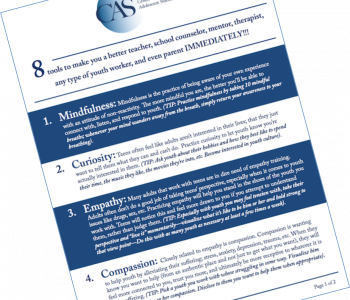

Catharine Hannay, MA
Catharine Hannay is the founder of MindfulTeachers.org and the author of Being You: A Girl’s Guide to Mindfulness, a workbook for teen girls on mindfulness, compassion, and self-acceptance.
3 Tips for Teaching Mindfulness to Christian Youth
Today I’d like to share with you:
- some guidance on how to communicate effectively with Christian youth (or their parents) who might have concerns about mindfulness instruction, and
- an overview of Christian mindfulness and contemplative practices.
Tip #1. Examine Your Own Assumptions
—If you’re a Christian yourself, or if you’ve worked with other Christian students or clients before, you might not realize that someone from a different denomination might have very different views about mindfulness and meditation.
—If you were trained in a Buddhist meditation tradition, or by secular teachers who were themselves trained in a Buddhist tradition, you might not be aware that there are also Christian practices related to movement and stillness, lovingkindness, contemplation, and insight.
—If you’ve heard about the lawsuits against school mindfulness programs, or seen extremists in the news, you might have a negative view of conservative Christians or evangelical Christians.
As my colleague Dr. Irene Kraegel points out,
“It is not only that some evangelical Christians have visceral reactions to mindfulness – it is also true that some mindfulness practitioners have visceral reactions to evangelical Christians. […] We are too often reacting to caricatures of one another rather than taking the time to actually know one another’s perspectives.” (See: Can Evangelical Christians Practice Mindfulness?”)
(For the record, the evangelical Christians I know personally are kind, well-intentioned people who’ve never initiated a lawsuit against anyone!)
2. Respectfully Discuss Any Concerns
I’ve never heard a Christian from any denomination object to breathing, being calm,
being kind, or intentionally directing one’s attention.
Some (but certainly not all) Christians worry that meditation involves ’emptying the mind,’ which could leave it open to evil influences.
Many Christians object to the use of mantras, or to specific types of phrasing, like referring to ‘sentient beings’ or saying ‘Namaste’ at the end of a yoga practice.
Other Christians have no trouble with mindfulness practice, either considering it separate from their worship or integrating it into their faith-based practices.
Dr. Season Mussey, author of Mindfulness in the Classroom: Mindful Principles for Social and Emotional Learning, says that:
“As a follower of Christ, I know there are many stories about when Jesus used mindfulness[…] I personally think that once understanding is achieved around the purpose and methods that teachers might use to promote mindfulness, that the objections would lessen. […] Sit down with anyone who has concerns, and have a grace-filled conversation. We can always learn from one another through mature, constructive dialogue.
I know of a situation where a mother dropped her objections after she was invited to sit in on a mindfulness lesson with her son—as soon as she’d experienced it for herself, she was reassured that he wasn’t receiving any kind of religious instruction.
In another case, after meeting with the mindfulness program coordinator, a mother still chose not to have her son participate. However, she felt that her views were respected, and she could see why other parents found the program beneficial. The coordinator told me that their conversation went very well after she stopped trying to convince the mother she was wrong and focused on trying to understand her point of view.
3. Share Christian Resources (as appropriate)
As I mentioned earlier, there are many ways that Christians practice mindfulness and meditation. Here are a few resources you might want to share with your Christian students or clients. As always, please preview anything you plan to share, and consider what’s appropriate for your particular context and most suitable to the specific youth under your care.
Guided Meditation
If your students or clients are uncomfortable with secular or Buddhist guided meditations, you might suggest alternate phrasing or approaches. For example, my sister (a Presbyterian pastor) does a variation on lovingkindness practice using phrases like “The Lord bless you and keep you.”
There are Christian-Adapted Meditation Scripts by Fernando L. Garzon at Liberty University. (scroll down to ‘additional files’); and
Dr. Irene Kraegel shares A Christian Approach to the Body Scan at MindfulTeachers.org.
Songs
‘Breathe’ by Christian pop singer/songwriter Jonny Diaz
He wants to take a break from constant stress and busyness to center himself, rest in God’s presence, and reflect on how to live more meaningfully.
‘Centering Prayer‘ by The Porter’s Gate ecumenical arts collective
Trying to be grounded, aware of physical surroundings, and present in the now. (refrain: “I wanna be where my feet are.”)
‘Exhale‘ by Christian alternative-rock singer/songwriter Plumb
A faith-based perspective on self-compassion and letting go. (refrain: “We breathe in your grace. And exhale.”)
Scripture/Biblical Passages
Focus on the Family lists a few verses from the New Testament that connect to mindfulness:
“The apostle Paul reminds Christians that they’re called to be mindful and live with an awareness of the present (Philippians 2:1-5);
Prayer is one very practical way Christians apply mindfulness to daily life (1 Thessalonians 5:17); […]
Christians shouldn’t let themselves to be distracted by worry about the future (Matthew 6:25-34). […]
Paul tells us to ‘be transformed’ by renewing our minds (Romans 12:2).’”
Dr. Irene Kraegel mentions some passages from the shared Judeo-Christian tradition of the Hebrew Bible and biblical prophets:
“God is just as interested in people being as he is in people doing. At the beginning of time, God took seven days to create the world – the last one was set aside for rest. So at the most basic level, God has structured our world to include times of stopping for rest, and he models this for us himself (Genesis 2:3). Because of this example, the Judeo-Christian tradition works in a day each week for Sabbath – time to quiet our souls and rest. […]
The Psalms are rich with meditation and silence, descriptions of quietness as a way of connecting with God. […] And in Ecclesiastes 3:1, we are reminded that ‘For everything there is a season, and a time for every matter under heaven,’ followed by a list of the many things for which there are times. One of these, beautifully, is ‘silence’ (verse 7).”
(See: What Does the Bible Say About Mindfulness and Compassion?)
Christian Contemplative Practices
Early Christian hermits (often called the “Desert Fathers and Mothers”) withdrew from the world to live in simplicity and contemplation, with similar guidelines and meditation practices as those found in Hindu and Buddhist renunciate traditions.
“While Jesus and his teachings were their inspiration, the meditative techniques they adopted for finding their God suggest either a borrowing from the East or spontaneous rediscovery. The ways of the Desert Fathers influence Christian monasticism to this day; their selfless love remains a guiding example.” (Daniel Goleman, The Meditative Mind: The Varieties of Meditative Experience
At U.S. Catholic, Christine Valters Paintner gives a brief introduction to the desert hermits, and shares four “Desert Practices” to bring the spirit of this tradition into contemporary life. (Interestingly, this includes “what Buddhists call ‘beginner’s mind,’” as well as setting aside time for solitude and silence.)
In her book The Mindful Christian: Cultivating a Life of Intentionality, Openness, and Faith, Dr. Irene Kraegel shares more “Mindfully Meditative Christian Practices,” including:
- “Centering Prayer can be viewed as a type of mindfulness meditation that focuses on God as the object of moment-to-moment awareness. […] This could be a ‘sacred word’ (such as peace or Father) or a ‘sacred breath’ that you attend to as a reminder of God’s presence. […] When you find yourself distracted by thoughts, feelings, or physical sensations, gently return your awareness once again to God’s presence.”
- “Listening prayer […] draws the practitioner into the present moment as an attentional exercise. The attitude of listening prayer acknowledges the temptation for humans to fill prayer with thoughts, words, and agendas. […] The goal of this practice is instead to listen for what God has to say in the present moment.”
(A longer explanation of these practices is available at mindfulteachers.org.)
Conclusion
Depending on your role, your institution, and your own beliefs, think about the most appropriate ways to engage with the Christian youth under your care. Reflect on your own views, thoughtfully engage with any concerns, and possibly share Christian mindfulness resources with them as an alternative to a secular approach.
To Learn More About Mindfulness for Christians…
At TheMindfulChristian.com, Dr. Irene Kraegel shares:
- guides for practice,
- reflections on Christian virtue and mindfulness,
- recommended audio guides and apps, and
- information about her book A Mindful Moment, which adapts Mindfulness-Based Stress Reduction (MBSR) practices for Christian youth.
At MindfulTeachers.org (https://www.mindfulteachers.org/blog/category/Christian),
I have blog posts on:
as well as Q+As with
- Dr. Emmanuel Ande Ivorgba, a seminary-trained educator and peace activist;
- David Harper, author of A to Z of Mindfulness for Christians;
- Dr. Irene Kraegel, author of The Mindful Christian: Cultivating a Life of Intentionality, Openness, and Faith; and
- KiYada Upshaw, a mindfulness coach for Black Christian women
Join the FREE Resilience Community for Helping Professionals to learn more about trauma-informed care, resilience, mindfulness, building relationships, and more! Our community features self-paced courses, a monthly live Zoom call, a weekly live meditation, and an online platform to connect with other providers/professionals in your field.
Related Posts
A Dozen Songs for Teaching Mindfulness to Teens
A Dozen Videos for Teaching Mindfulness to Teens
Three Dangerous Misunderstandings About Mindfulness
9 Guidelines for Teaching Trauma-Informed Mindfulness to Teens

